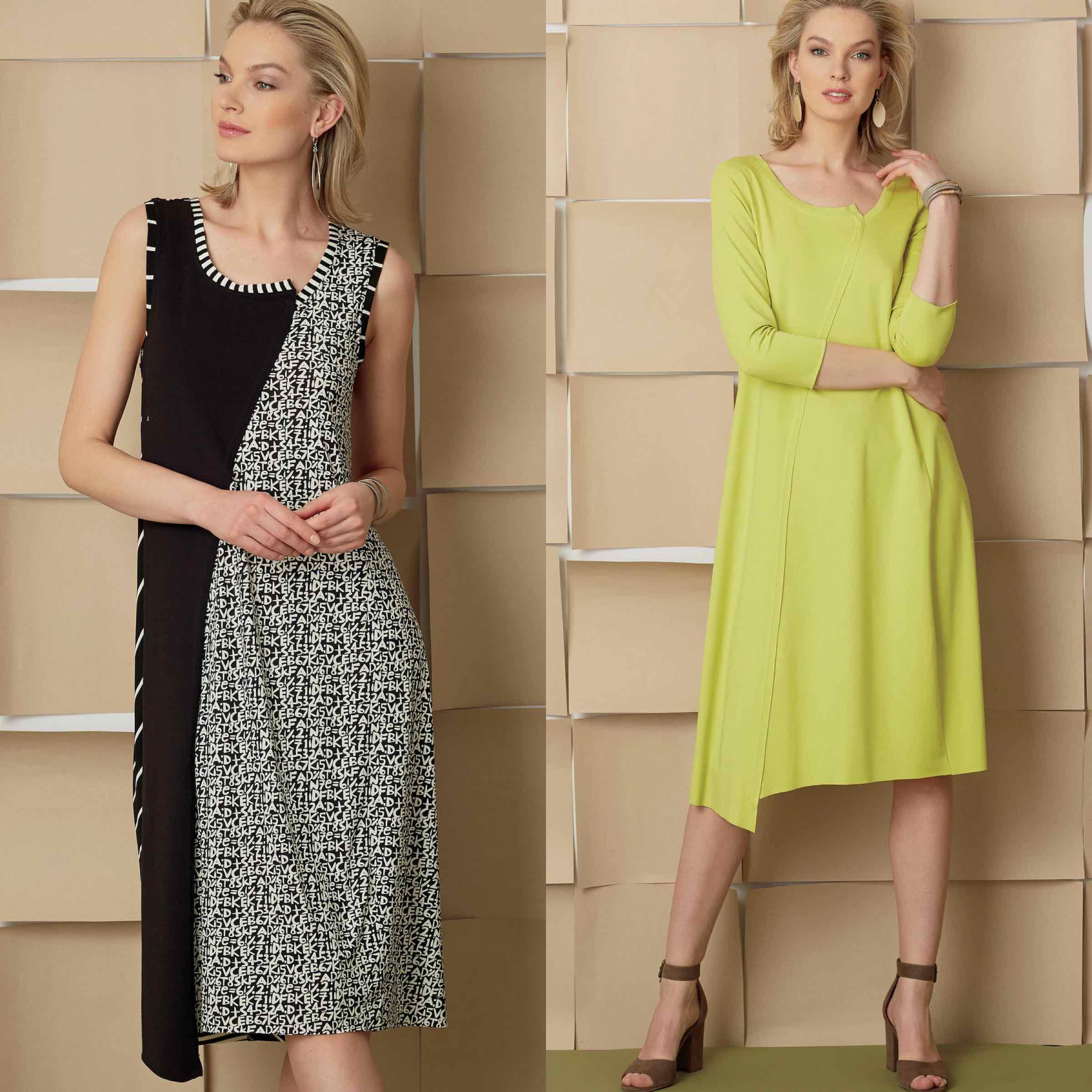Designed for knits: ponte, double knits, cotton/lycra, rayon/lycra, light weight scuba or sweatshirt knits all would work. Make it in one color, or combine prints or do color blocking.
- This makes a knockout little black dress with or without sleeves.
- I am also seeing it as a tunic or t-shirt by simply shortening it withIn the pattern.
- If you want to make a 'collage' version using different fabrics, it is a good idea to assemble a grouping and test to be sure the weights work together. You'll need approx. 1 1/2 yards each.


The black and white version is a mix of 4 different knits:
- The 2 stripes are bamboo/lycra jersey
- The print is a poly/lycra ITY jersey
- The black is a cotton/lycra jersey that is slightly heavier than the others

Marcy's version uses 5 different knits.
- The stripes are bamboo/lycra jersey
- The print is a French digital print viscose lycra jersey
- The front black panel is our Prime Time Black Knit (a great basic)
- The sleeves are a light weight burn out.
- Hems are all left raw.

Front Details
- The neck binding is sewn before the center front seam is stitched
- The neck binding is the selvedge edge which curls. The short ends on the neck edge are turned under and stitched in place
- The top and bottom edges are offset.
- Stitch center front seam WRONG SIDES TOGETHER, matching edges at markings.
- Press flat as sewn, press seam open, then press both seams toward front left.
- Trim the underneath seam allowance to about ¼”
- Topstitch; working from the right side and using a double needle, topstitch through the seam allowance, stitching close to/next to the seam.
- The very top neck edge will develop a slight curve, this is not a problem, it is part of the design!
- Both the neck edge and center front seam use a double needle finish which holds things in place. DO make test samples with your fabric to determine which double needle size and width to use.
- I keep a variety of double needles in my stash and replace them regularly as the points can get dull.

The black is kicked back on this shot to show the double needle stitching detail.

The back uses 'dimensional extensions', a shaping in the seam which creates a bit of dimension, weight and shaping.

Fitting
Tissue fit the pattern as if you were sewing a t-shirt, here are a couple of videos that show how to do it.Cutting knits on the bias is something I tried out of desperation once, (not enough fabric), and it worked! I continue to cut knits on the bias and it is easy with none of the trials and tribulations that can come with cutting woven fabrics on the bias...that is another lesson for another day.
Take a look at this video on cutting knits on the bias. I can't promise that every knit will always work, but I do encourage experimentation!
Q & A about this dress
I see it calls for knit...could I make it in linen? I could see a frayed edge down the front!- The dress is designed for knits only. If you want to make in a woven it will mean some serious testing.
- I’d first make a ‘muslin’ in a stable knit like a ponte first and adjust from there.
- I have not tried the dress in a woven, but have considered the bias idea and wondered about a stretch woven.
- Only testing and trial and error will tell….
- If you want to use different fabrics, you’ll need 1 ½ yards of each for the length of the dress.
- If you are using 4 different fabrics, you'll need 4 cuts of 1 1/2 yards each. I save my scraps for other projects.
- I recommend using 2” seam allowances at the side seams to allow for the weight of the knit stretching a bit. Jersey, especially those with 4 way stretch can ‘grow’ and get longer and thinner, so having some fitting ‘insurance’ is a good idea, and you can adjust the side seams at the final fitting.
- I use the 2" seam allowance on the sleeves as well, and adjust the fit on the sleeve and at the wrist too. Some knits have more stretch and I want the fit at the bicep and wrist to be comfortable.
- I use a lot of black and white stripes and dots as ‘blenders’ when combining prints.
- I collect stripes, the one fabric I never regret having on hand.
- I buy 2 yards which gives enough length for most projects and allow for shrinkage.
- Consider using a solid color for one panel as we did on the pattern envelope.
- You could also use a sheer mesh knit or lace for the sleeves.
- The dress is shown for summer on the pattern envelope, but it would work well in a ponte, double knit, even a lighter weight scuba.
- No, it came from from my stash





